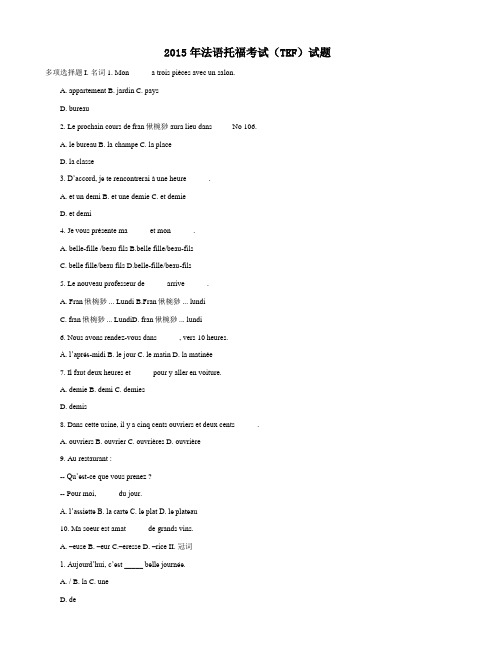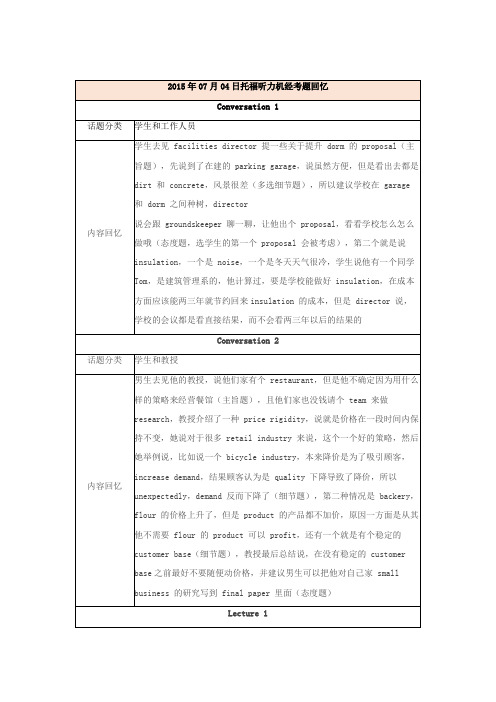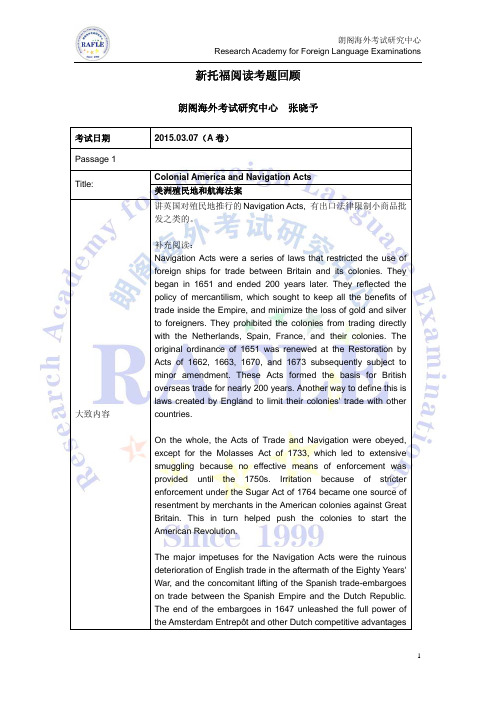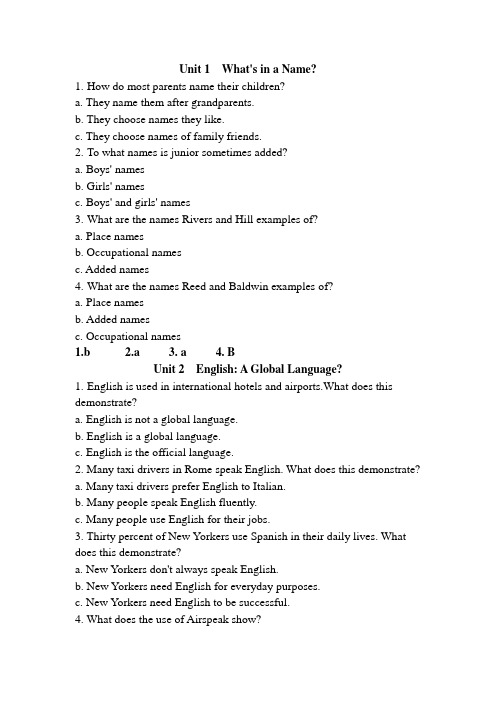2015年03月07日新托福听力考题回顾
2015.3月托福听力考试真题

2015.3月托福听力考试真题本周托福考试又是出现AB两套卷,预计本月剩余两场考试考AB卷的概率极小。
同时,4月备考的同学一定会有一场AB(2014年第二次AB卷就发生在4月12日)。
不过,整体难度不变,还是一样难~~~ 对话场景分布依然是:一个办公时间,一个服务咨询;讲座学科分布都是高频学科:社会学科——考古、生命学科——动物、自然科学——地理气象和艺术——美术,雕像。
Conversation 1:教授问女生一个课外活动反馈,healthcare类,还说下半学期不打算开了,但女生觉得非常不错。
女生找他写推荐信,两人还讨论了一个新建的healthcare center之类。
解析:第一个对话是办公时间场景,边听边整理篇章的结构,按照:提出问题(P)——分析问题(C)——解决问题(S)三个板块,但是小伙伴们会发现这篇篇章的内容比较松散,主旨不突出,混淆性的信息比较多(活动反馈health care等等),一定要谨记学生过来找教授(或其他人)的目的、要解决的问题才是主旨的答案,不要听着听着就被带着走~~Lecture1:earth science:先讲一种花younger D,这种花适应低温,在冰河时期生存,可是突然灭绝了,意味着地球在短时间内回温,可是这与以往的理论(气温回暖的过程很漫长)相悖。
科学家通过化石提供的证据(这里没有考点)给出两种解释:冰融化,水面上升,把花淹没;小行星撞地球,极端环境出现,导致冰融化,水面上升,把花淹没。
讲了一堆小行星理论的证据,比如发现坑,高浓度Ir。
两种理论都提到水面上升(考点)。
解析:冰河世纪在TPO中有两种说法:ice age以及Pleistocene epoch。
自然科学考察最多的是天文和地质学。
天文学的篇章的结构基本可以归纳为:科学谜团—假说或理论—最后教授揭秘或表述态度。
可以通过看discovery等学科视频补充学科词汇和知识背景,同时锻炼听辨速度和能力~Lecture2:art history:关于古希腊和罗马雕塑。
2015年3月高考听力原文及答案

2015年3月高考听力原文及答案录音原文Example:M: Excuse me, can you tell me how much the shirt is?W: Yes, it's nine-fifteen.Text 1W: What time is your train leaving?M: It leaves at ten. I've got fifty minutes left.W: You'd better hurry, or you won't be able to catch it.Text 2M: Nice weather we're having, don't you think?W: No. It is too cold.M: I think it is just right.W: I'd prefer it a few degrees warmer.Text 3M: Now, let's stop talking and get going. I need to be in my office in fifteen minutes, or I'll be late for a meeting.W: Okay, bye.Text 4M: This course is really difficult.W: I don't think it's all that bad. And we'll benefit a lot from it.M: So, you're taking it too?W: That's true.Text 5W: Could you turn that off? I can't hear myself think.M: What?W: The radio.M: Oh! Sorry.Text 6W: Hi Michael! I heard you just came back from a holiday. M: Yes. I stayed for a week in China, and five days in India. W: You do travel a lot, don't you? Last year, you went to Norway, right?M: Well, I've been to quite some countries, but not yet to Norway. Last summer, I toured Russia for two weeks.Text 7M: Sally, do you like seafood?W: Yes, of course.M: Is there anything you especially like?W: Well, I really don't know. I can never remember the names.M: Okay. Is there any food you don't eat?W: Well, I don't eat chicken. And I don't like eggs, either. But I like all kinds of fish and vegetables.M: Then let's look at the menu and see what they've got for us.Text 8M: You look pale, Stephanie. What's wrong?W: I don't feel good. I have a bad headache. In fact, I haven't got much sleep this past week, and I feel really tired.M: Why don't you go to see a doctor?W: Yeah, I think I should. But I have a report due tomorrow. Ms. Jenkins needs it for the board meeting next Monday. M: Well, it's Wednesday today. Why don't you talk to Ms. Jenkins, and ask if you can hand it in on Friday morning? W: Maybe I should try. I guess I just need a good sleep. Thanks, George.M: If you need any help with the report, just let me know. Text 9W: Anything interesting in the paper today, dear?M: Well, yeah. There are a few here that might interest us. Here's one for just four hundred dollars. It only has one bedroom, but it sounds nice, near Lake Street.W: Yeah. Let me see what the cheapest two-bedroom apartment is. Oh, here's one on Market Street. It's a real bargain. Only three hundred and fifty dollars. But it doesn't have any furniture.M: Well, it costs a lot to buy all the furniture.W: Oh, here's another one for just over four hundred dollars. This sounds very interesting! It's on South Street. That's a nice area.M: Yes, it's quiet. Did you say two bedrooms?W: Yes, at four hundred and fifteen dollars.M: Why don't we go and have a look?W: Okay, I'll give them a call.Text 10Look at this picture. It's the London Tea Trade Centre. As you can see, it is on the north bank of the river Thames. It is the center of an important industry in the everyday lives of the British people. Tea is the British national drink. Every man, woman, and child over ten years of age has on average over four cups a day. Or some one thousand, five hundred cups annually. About thirty percent of the world's exports of tea makes its way to London. And Britain is by far the l argest importer of tea in the world. Now, in the second picture, youcan see how tea is tasted in the Tea Trade Center before it is sold. Here, different types of tea are tasted by skilled tea tasters, before they're sold at each week's tea sale. It's amazing to see them at work. Over a hundred kinds of tea are laid out in a line on long tables. The tasters generally taste teas with milk, since that is how the majority of British people drink their tea. The tasters move down the line with surprising speed, tasting from a spoon and deciding what is a fair price for each tea. After that, they…参考答案:1-5: ACABC6-10: BABCB11-15: ABCAB16-20: CBAAC。
2015年高考英语试卷听力+原文+答案(新课标Ⅰ、Ⅱ)

2015年全国统一高考英语试卷(新课标I、Ⅱ)听力试题第一部分听力(共两节,满分30分)做题时,先将答案标在试卷上,录音结束后,你将有两分钟的时间将试卷上的答案转涂到答题卡上。
第一节(共5小题,每小题1.5分,满分7.5分)听下面5段对话。
每段对话后有一个小题,从题中所给的A、B、C三个选项中选出最佳答案。
听完每段对话后,你都有10秒钟的时间来回答有关小题和阅读下一小题。
每段对话仅读一遍。
例: How much is the shirt?A. £ 19.15B. £9.18C. £9.15答案是C.1. What time is it now?A. 9:10.B. 9:50.C. 10:00.2. What does the woman think of the weather?A. It’s nice.B. It’s warm.C. It’s cold.3. What will the man do?A. Attend a meeting.B. Give a lecture.C. Leave his office.4. What is the woman’s opinion about the course?A. Too hard.B. Worth taking.C. Very easy.5. What does the woman want the man to do?A. Speak louder.B. Apologize to her.C. Turn off the radio.第二节(共15小题;每小题1.5分,满分22.5分)听下面5段对话或独白。
每段对话或独白后有几个小题,从题中所给的A、B、C三个选项中选出最佳选项,并标在试卷的相应位置。
听每段对话或独白前,你将有时间阅读各个小题,每小题5秒钟;听完后,各小题将给出5秒钟的作答时间。
每段对话或独白读两遍。
2015年3月公共英语三级真题及答案解析

B.In a hospital.
C.At a bank.
D.In a store.
上一题下一题
(11~13/共15题)You are going to hear four conversations. Before listening to each conversation, you will have 5 seconds to read each of the questions which accompany it. After listening, you will have time to answer each question by choosing [A]、[B]、[C] or [D]. You will hear each passage or conversation ONLY ONCE. Mark your answers in your test booklet.
Play00:00…
Volume
第14题
Where is the Bank of English created?
A.At the University of Buckingham.
B.At the Oxford University.
C.At the Cambridge University.
D.At the University of Birmingham.
C.The professor had chosen a mystery book for him instead.
D.The homework assignment isn´t clear.
第9题
What does the man mean?
2015年法语托福考试(TEF)试题

2015年法语托福考试(TEF)试题多项选择题I. 名词 1. Mon _____ a trois pièces avec un salon.A. appartementB. jardinC. paysD. bureau2. Le prochain cours de fran愀椀猀 aura lieu dans_____ No 106.A. le bureauB. la champeC. la placeD. la classe3. D’accord, je te rencontrerai à une heure _____ .A. et un demiB. et une demieC. et demieD. et demi4. Je vous présente ma _____ et mon _____ .A. belle-fille /beau filsB.belle fille/beau-filsC. belle fille/beau filsD.belle-fille/beau-fils5. Le nouveau professeur de _____ arrive _____ .A. Fran愀椀猀 ... LundiB.Fran愀椀猀 ... lundiC. fran愀椀猀 ... LundiD. fran愀椀猀 ... lundi6. Nous avons rendez-vous dans _____ , vers 10 heures.A. l’après-midiB. le jourC. le matinD. la matinée7. Il faut deux heures et _____ pour y aller en voiture.A. demieB. demiC. demiesD. demis8. Dans cette usine, il y a cinq cents ouvriers et deux cents _____ .A. ouvriersB. ouvrierC. ouvrièresD. ouvrière9. Au restaurant :-- Qu’est-ce que vous prenez ?-- Pour moi, _____ du jour.A. l’assietteB. la carteC. le platD. le plateau10. Ma soeur est amat _____ de grands vins.A. –euseB. –eurC.–eresseD. –rice II. 冠词1. Aujourd’hui, c’est _____ belle journée.A. /B. laC. uneD. de2. Il pleut souvent en automne à Paris. Je déteste _____ pluie.A. uneB. laC. de laD. de3. Que désirez-vous, _____ monsieur ?A. unB. leC. /D. la4. J’aime bien prendre _____ tasse de café après _____ déjeuner.A. une ... unB. la ... leC. une ... leD. la ... un5. Faites _____ attention _____ voitures, quand vous sortez de l’école, mes enfants.A. l’ ... auxB. / ... auxC.une ... auxD. l’ ... à6. Il met _____ sucre dans son café.A. duB. deC. /D. de la7. _____ chocolat, je n’en ai plus.A. UnB. LeC. DuD. /8. Cette belle fille joue _____ Chopin.A. à laB. deC. duD. la9. Fermez _____ fenêtres s’il vous pla琀.A. lesB. /C. desD. de10. Voici une pomme, une pêche ; tu prends _____ pomme ou _____ pêche ?A. une ... uneB. la ... laC. dela ... de la D. de ... de11. Quels sont _____ monuments que vous aimez à Paris?A. desB. lesC. deD. /12. _____ Terre tourne autour _____ soleil.A. Une ... unB. La ... leC. La... duD. La ... un13. J’ai _____ devoirs à faire.A. lesB. desC. deD. /14. Il y a _____ jeunes filles et quelques jeunes gens sur le terrain de sport.A. deB. /C. desD. les15. Il y a _____ soleil aujourd’hui.A. unB. leC. duD. de laIII. 形容词1. Quel _____ objet ! Je le veux.A. belleB. beauC.beauxD. bel2. Elle a une veste et un pantalon _____ .A. vertB. vertsC.verteD. vertes3. _____ printemps est _____ saison.A. Le ... un beauB. La ... un beauC. Le ...une belleD. La ... une belle4. Cette _____ femme a 97 ans.A. vieuxB. ancienC.vieilleD. ancienne5. Elle est restée _____ malgré son 最攀.A. actifB. activeC.actifeD. activesIV. 代词1. La campagne ? Ils _____ vont tous les dimanches.A. enB. leC. laD. y2. _____ l’a retrouvé hier.A. NulB. PersonneC. OnD. Ils3. Rendez _____ livres.A. leur leurB. leurs leurC. leursleurs D. –leur leurs4. Les élèves sont habillées _____ en bleu.A. toutB. chacunC. touteD. tous5. Ne _____ pas !A. montrez-le-luiB. lui le montrezC.montrez-lui leD. le lui montrez6. _____ est-ce _____ on va manger ?A. Qu’ ... quiB. Qu’ ... qu’C.Qui ... quiD. Qui ... que7. –Savez-vous qu’il est difficile de conduire à Paris ?- Non, nous ne _____ savons pas.A. laB. leC. enD. /8. Partez, puisque vous _____ voulez.A. /B. laC. leD. en9. Vous êtes intelligent, il _____ est aussi.A. laB. leC. l’D. en10. Elle ouvre sa valise, et _____ sort des livres.A. yB. enC. d’enD. les11. –Vous intéressez-vous à la musique ? -Oui, je m’ _____ intéresse beaucoup.A. yB. enC. y laD. en la12. S’il te pla琀 _____ .A. prête-les-luiB. les lui prêteC. prête-lui lesD. lui les prêteV. 限定词1. _____ homme est très honnête.A. CetB. CeC. CetteD. c’est2. Voici vingt et _____ francs.A. uneB. unsC. unD. deux3. Peux-tu me prêter _____ voiture ?A. tonB. votreC. taD. ma4. Ils ont quitté _____ père, _____ mère et _____ amis.A. son ... sa ... sesB. leur ... leur ... leurC. leur ... leur ... leursD. leur ... leur ... ses5. M. Wang habite au _____ étage.A. troisB. trenteC.troisièmeD. trentaine6. _____ de personnes l’entouraient.A. Une dizaineB. La dizaineC. Le dizaineD. Un dizaine7. _____ temps fait-il ?A. QuelB. QuelleC. QuelsD. Quelles8. _____ beaux chapeaux !A. QuelB. QuelsC. QuelleD. Quelles9. Vous pouvez acheter _____ fleurs, mais à condition qu’elles ne soient pas trop chères.A. n’importe commentB.n’importe quelsC. n’importe lesquellesD.n’importe quelles10. _____ langue a ses difficultés.A. ToutB. TouteC. Tout leD. Toute la11. Ils habitent ici depuis quatre- _____ ans.A. vingtsB. douzeC. unD. vingt参考答案: I. 1. A 2.D 3. C 4. D 5. D 6. D 7. A 8. C 9. C 10. B II. 1. C 2. B 3. C 4. C 5. B 6. A 7. C 8. C 9. A 10. B11. B 12. C 13. B 14. C 15. C III. 1. D 2. B 3. C 4. C 5. B IV. 1. D 2. C 3. D 4. A 5. D6. B7. B8. C9. C 10. B11. A 12. A V. 1. A 2. C 3. C 4. C 5. C6. A7. A8. B9. D 10. B 11. A。
2015年托福听力考题回忆(7-12月)

话题分类
Global warmingsolution
内容回忆
讲座讲到的是一种预防 global warming 的方法,cloud brightening,以此来降低 radiation(主旨题),先介绍了什么叫 cloud brightening,就是通过方法增加云层厚度,从而增加云层的 reflection(细节题),主要的原理是因为水中有 salt,而在 salt 分子外,watervapor比较容易聚集,接着讲到了测量,说了两种仪器,后者比前者好,原因是因为 wind resistant,且易安装在船上(细节题),但是讲了一系列的技术难题,比如说在某个板上要有均匀分布的 holes,所以对于材料要求比较高,可以考虑 silicon,但是有难度(有细节题),最后男生问是不是解决了这些技术问题以后,global warming 问题就可以得到解决,教授说也不一定,因为不知道对水环境和海洋环境造成什么样的 potential
到的水面,有的 deeper到 predator 不能看到的深度,且水中还有 luminous的生物,所以这个 explanation 不可信,另外还讲到两个theory,说可能是防紫外线,也可能是在 cold water 中 save energy(有细节题),总之这种现在在各个水域不同物种中普遍存在,但是没有单一的 explanation 可以解释到所有的现象(态度题)
Lecture 2
话题分类
Anthropology
内容回忆
讲座讲到两个生活在极寒区域的人种,一种 D 最后 disappear 了,一种 survive且迁移了(主旨题),一开始是 D 的人种,他们什么都会捉,除了 whale,他们还会因地取材建造房子,当他们的栖息地没有动物皮毛的时候,他们就用 snow建造房子(细节题),紧接着,不知道为什么,在 1000 多年前,D 的 population就开始 shrink,最后消失,这个时候就有 T 人种出现,教授说不知道是不是因为T 人种的出现导致了 D 人种的 disappearance,但是可以确定的是,T 人种很好地适应了环境(有细节题),与 D 人种不同的是,他们可以造船,还可以制作特别的 spear,所以他们会捕捉鲸鱼(有多选细节题),也是因为这个原因,随着后期的 temperature 升高,水面的冰逐渐融化,whale 开始向 north 迁移,使得这个人种随着 whale 也一起迁移了
2015年03月07日新托福阅读考题回顾

新托福阅读考题回顾朗阁海外考试研究中心张晓予考试日期 2015.03.07(A卷)Passage 1Title: Colonial America and Navigation Acts 美洲殖民地和航海法案大致内容讲英国对殖民地推行的Navigation Acts, 有出口法律限制小商品批发之类的。
补充阅读:Navigation Acts were a series of laws that restricted the use of foreign ships for trade between Britain and its colonies. They began in 1651 and ended 200 years later. They reflected the policy of mercantilism, which sought to keep all the benefits of trade inside the Empire, and minimize the loss of gold and silver to foreigners. They prohibited the colonies from trading directly with the Netherlands, Spain, France, and their colonies. The original ordinance of 1651 was renewed at the Restoration by Acts of 1662, 1663, 1670, and 1673 subsequently subject to minor amendment. These Acts formed the basis for British overseas trade for nearly 200 years. Another way to define this is laws created by England to limit their colonies' trade with other countries.On the whole, the Acts of Trade and Navigation were obeyed, except for the Molasses Act of 1733, which led to extensive smuggling because no effective means of enforcement was provided until the 1750s. Irritation because of stricter enforcement under the Sugar Act of 1764 became one source of resentment by merchants in the American colonies against Great Britain. This in turn helped push the colonies to start the American Revolution.The major impetuses for the Navigation Acts were the ruinous deterioration of English trade in the aftermath of the Eighty Years' War, and the concomitant lifting of the Spanish trade-embargoes on trade between the Spanish Empire and the Dutch Republic. The end of the embargoes in 1647 unleashed the full power of the Amsterdam Entrepôt and other Dutch competitive advantagesin world trade. Within a few years, English merchants hadpractically been overwhelmed in the trade on the IberianPeninsula, the Mediterranean and the Levant. Even the tradewith English colonies (partly still in the hands of the royalists, asthe English Civil War was in its final stages and theCommonwealth of England had not yet imposed its authoritythroughout the English colonies) was "engrossed" by Dutchmerchants. English direct trade was crowded out by a suddeninflux of commodities from the Levant, Mediterranean and theSpanish and Portuguese empires, and the West Indies via theDutch Entrepôt, carried in Dutch ships and for Dutch account. Passage 2Title: Mass Production: Method and Impact 大生产:方法和影响大致内容讲工业革命造成产品过剩,通过广告和其他一些手段推销产品。
2015上半年研究生英语考试听力试题及答案

Unit 1 What's in a Name?1.How do most parents name their children?a. They name them after grandparents.b. They choose names they like.c. They choose names of family friends.2.To what names is junior sometimes added?a. Boys' namesb. Girls' namesc. Boys' and girls' names3.What are the names Rivers and Hill examples of?a. Place namesb. Occupational namesc. Added names4.What are the names Reed and Baldwin examples of?a. Place namesb. Added namesc. Occupational names1.b2.a3. a4. BUnit 2 English: A Global Language?1.English is used in international hotels and airports.What does this demonstrate?a. English is not a global language.b. English is a global language.c. English is the official language.2. Many taxi drivers in Rome speak English. What does this demonstrate?a. Many taxi drivers prefer English to Italian.b. Many people speak English fluently.c. Many people use English for their jobs.3. Thirty percent of New Yorkers use Spanish in their daily lives. What does this demonstrate?a. New Yorkers don't always speak English.b. New Yorkers need English for everyday purposes.c. New Yorkers need English to be successful.4. What does the use of Airspeak show?a. People need a common language for special situations.b. People are becoming more fluent in English.c. Pilots should be fluent in several languages.1.b2.c3.a4.aUnit 3 High Anxiety: Phobias1 .What word describes the reaction of someone with a phobia?db.Extremec.Normal2.What is the main idea of the first theory?a. Phobias are uncontrollable.b. Phobias are common.c. Phobias are learned.3.How are phobias classified?a. By what people fearb. By how people reactc. By the problems they cause4.What is the main idea of the second theory?a. Phobias are the problems themselves.b. Phobias are signs of deeper problems.c. Phobias are quite easy to control.1.b2.c3.a4.bUnit 4 TV:What We Watch1.How does TV influence our culture?a. It influences our work.b. It influences our clothes.c. It influences our literature.2.According to Robert C. Allen, why are soap operas popular?a. People like the universal themes.b. People are interested in culture.c. People everywhere have TVs.3.According to the speaker, why do people watch soap operas every day?a. They identify with the characters.b. They have a lot of free time.c. They like the advertising.4.According to the speaker, what do soap opera and evening TV writers both try to do?a. Create a continuing storyb. Create funny charactersc. Create character loyalty1.b2. a3.a4.cUnit 5 Learning Differently1 .What main idea was discussed in the lecture?a. Dyslexic students need special schools.b. Dyslexic students need teachers who can be flexible.c. Dyslexic students shouldn't attend school.2.A dyslexic girl's father also has dyslexia. What does this show?a. Dyslexia may cause problems at school.b. Dyslexia may be hard to treat.c. Dyslexia may be an inherited condition.3.What is true about children with dyslexia?a. They generally score well on intelligence tests.b. They generally appear intelligent to their teachers.c. They generally follow directions well.4.What is Dr. Levinson's goal?a. To help dyslexic students do better at schoolb. To build special schools for dyslexic studentsc. To use computer chips to help dyslexic children1.B2. C3.A4.AUnit 6 Immigration:Bound for the United States1.What is immigration?a. A permanent move to another countryb. A temporary move to another countryc. A forced move to another country2.What was true about immigration in the colonial period?a. Most immigrants were from Spain or France.b. Everyone was allowed to immigrate to the United Stares.c. Most immigration was not voluntary.3.What was the main reason for the second immigration wave?a. The industrial revolution in Europeb. Families and friends in the United Statesc. Jobs on farms in California4.What was the main difference between the second and third waves?a. Why the immigrants came to the United Statesb. What work the immigrants didc. Where the immigrants came from1. A2. B3.A4.CUnit 7 Who’s Calling the Shots?1 .What idea is Mrs. Gomez's team-building plan based on?a. A good manager always works very hard.b. A good manager rewards employees for their work.c. A good manager tells employees what to do.2.What is the goal of the picnic in the park?a. To give the employees a break from the officeb. To make the employees like the new managerc. To help the employees work better together3.Why do managers want employees to share their ideas?a. So the employees understand that management is in controlb. So the employees know that management values their ideasc. So the employees understand why changes are occurring4.What is the main attitude shown by the team-building plan?a. Employee relations is important.b. Managers can make mistakes.c. Management styles often vary.1. B2. C3. B4.AUnit 8 Right and Wrong on the Net1.What is the goal of the Computer Ethics institute?a. To provide guidelines for ethical computer useb. To increase the use of computers in schoolsc. To solve computer problems caused by hacking2.What action would the speaker consider ethical?a. Reading a friend's e-mailb. Using a friend's screen namec. Downloading free software3.What statement can we infer from the lecture?a. Students should use the Internet ethically.b. Students should stop using the Internet.c. Students should enforce computer ethics rules.4.What are acceptable-use policies?a. Government laws about computer useb. School rules about Computer usec. Student-made guidelines about computer use1.A2.C3.A4.BUnit 9 Which Way Will It Go?1.What is the main topic of the lecture?a. Global weather changesb. The loss of productive landc. Overgrazing of farm animals2.Why does the speaker mention the growing world population?a. To emphasize that land is very expensiveb. To emphasize that people live on every continentc. To emphasize that the problem will get worse3.About how much of the world's land is unproductive?a. A quarterb. A Thirdc. Half4.What is one major’effect of overgrazing?a. Fewer planrs grow.b. Less rain falls.c. Fewer animals graze.1. B2.C3.B4.AUnit 10 It's in the DNA1 .What did Warson and Crick discover?a. The existence of genesb. The complete set of human genesc. The structure of DNA2.Why can DNA be used to test identity?a. Because everyone has a unique DNA sampleb. Because everyone has different health problemsc. Because everyone reacts to medicine differently3.Certain genes are linked to some diseases. What does this mean?a. Defects in these genes cause the diseases.b. Defects in these genes may cause the diseases.c. Defects in these genes prevent the diseases.4.What is the main benefit of targeted medicine?a. It increases drug sales.b. it saves dives and money.c. It prevents genetic defects.1. C2. A3.B4. BUnit 11 Staying Healthy1.Why are diseases spreading more rapidly?a. People have weaker immune systems.b. People are traveling more internationally.c. Environmental problems are increasing.2.What is one main point of the lecture?a. We need to be careful in international airports.b.Travel to Europe can cause problems.c. We need to be aware of risks and take precautions.3.What does adaptive immunity enable us to do?a. Fight diseases where we liveb. Travel to other countriesc. Develop treatments4.Why do people get shots before they travel?a. It helps to increase immunity.b. It makes the immune system work overtime.c. It helps treat some diseases.1.B2.C3.A4.AUnit 12 Prepare, Prepare1.What is not a common result of a natural disaster?a. Property damageb. Disruption of normal lifec. Loss of ocean life2. What is the main goal of an emergency response plan?a. To prevent natural disastersb. To prepare for natural disastersC. To predict natural disasters3.What is the first stage of an emergency response plan?a. Researching and planningb. Recovering and rebuildingc. Organizing emergency supplies4.What is the second stage of an emergency response plan?a. Researching and planningb. Recovering and rebuildingc. Organizing emergency supplies1.C2. B3.A4.C。
- 1、下载文档前请自行甄别文档内容的完整性,平台不提供额外的编辑、内容补充、找答案等附加服务。
- 2、"仅部分预览"的文档,不可在线预览部分如存在完整性等问题,可反馈申请退款(可完整预览的文档不适用该条件!)。
- 3、如文档侵犯您的权益,请联系客服反馈,我们会尽快为您处理(人工客服工作时间:9:00-18:30)。
新托福听力考题回顾
朗阁海外考试研究中心胡佳琴
考试日期 2015.03.07(A卷)
是否加考是
场景话题内容描述考题回忆
Listening 1 对话教授找学生问她课堂上布置的关于health care的实习feedback。
教授说很多同学的feedback反应这个项目不理想,下学期想取消这个项目,但学生说她收获很多,并确定了以后的方向,想继续研究社会学领域关于health care方面的内容,希望教授能给她写推荐信。
然后教授提到学校附近新开了一个诊所,学生认为这很好,因为在医院看病的人很多很忙,她希望以后可以在诊所里干活。
Listening 2 考古学主要讲北美沿海一带的古人如何生火及使用火(除了照明外)。
先讲生活中的例子:在高速公路上看到路边的村庄有火,用树枝维持火,引出古人也是用同样的方法。
学生质疑是否是因为古时候雷电生火,教授反驳,原因如下:首先,科学家研究的地方很少有闪电;其次,从土壤的研究可以得知这些火出现于特定的时间和季节,这些都证明这是人类生火。
然后说古时候人类利用火烧一些植物维持diversity给他们提供食物,动物们也依靠植物生存,最终人类猎捕动物受益。
这些利用火的方法到今天都是很有意义的。
Listening 3 生物学主要讨论动物是否有通过叫声传递信息的本领。
刚开始教授提问,动物用声音交流除了传递简单的信息,是否附带其他的信息?学生举例说猴子发出叫声表示自己害怕,同时利用叫声告诉同伴predator来了,还能传递方向。
然后教授举了狗叫的例子,其中有一种又可以分成3种,一是面对食物,二是面对敌人,三是面对游戏。
科学家做实验把狗分成三组关在笼子里,每组12条,笼子外有骨头,笼子上有音响。
当打开笼子放出狗时,第一组中的12条中10条有反应,第二组和第三组没什么反应,因此,研究人员确定同样是狗叫却有区别,包含不同的信息。
科学家分析三种叫声发现第三组的频率更高更短促,第一组和第二组的声音较长,很符合常理。
但设备无法识别第一组和第二组有何显著的差别,所以科学家们无法明白这点,或许还需要新的理论。
Listening 4 对话女生去咖啡厅找老板要求在考试期间延长营业时间,因为咖啡厅的环境比图书馆好,而且还有咖啡和小吃。
老板说这个很麻烦,需要学校批准,拨款付给加班的员工,
还需要学校延长供电时间;另外,还要在学生中做调查,了解学生是否真的有需要。
所以他不能保证在下周之前(考试周)满足学生的要求,但可以保证在下学期的考试周提供这样的服务。
最后,老板建议学生可以去另一个大家都会去的地方自习,那里会提供一个小柜台卖吃的,学生觉得很好。
Listening 5 自然科学先讲了一种叫做Younger D的花,说这种花适应低温,在冰河世纪生存,可是突然灭绝了,这意味着地球在短时间内回暖,可是这与以往的理论(气温回暖的过程很漫长)相悖。
科学家通过化石提供的证据(这里没考点)给出两种解释。
第一,冰融化,水面上升,把花淹没。
第二,小行星撞击地球,出现极端环境导致冰融化,水面上升,把花淹没。
讲了一堆小行星理论的证据,比如发现坑,高浓度lr, 两种理论都提到水面上升(这里有考点)。
Listening 6 艺术主要介绍了希腊和罗马的雕塑。
学生先谈了参观完博物馆后的感受,希腊雕塑的人体很美,罗马雕塑copy了希腊雕塑。
教授从希腊雕塑讲起,分两个时期。
前一个时期的雕塑塑造非常理想的人体美,后一个时期变得realistic, 描绘普通人。
然后讲到罗马雕塑,大多是半身像,借鉴希腊雕塑,但面部更加realistic, 有政治因素,体现统治者和将领的权威(有多选题),可能是因为罗马人以前制作面具(用wax),对面部的雕刻技艺娴熟。
然后举了一个雕塑的例子,神情很难猜测,不同的人有不同的理解,教授认为他可能在对民众微笑。
*Listening 7 女生丢ID card / 鸟类迁徙(经典加试)
*Listening 8 William Wordsworth / 大王花(经典加试)*Listening 9 神经元细胞/ Ragtime music(经典加试)
考试日期 2015.03.07(B卷)
是否加考是
场景话题内容描述考题回忆
Listening 1 对话学生临时提出更改观看展览的计划,出发前告诉老师,提出一部分人走着去,因为会路过一个废弃的轨道改造的公园,一部分人坐公交车去。
Listening 2 自然科学讲Heliocentrism文艺复兴的伽利略提出的太阳中心论,为什么有人即使听懂也不相信,很难理解地球处于高速运转。
Listening 3 生物学主要讲一种植物的近亲到底是什么,有一个科学家认为是墨西哥的一种植物,首先他们的基因除了三个其他的都高度吻合,外表相似,但果实不一样。
Listening 4 对话学生想回去做个实验,研究动物伪装的课题,蝴蝶和蛾类会用翅膀上的图案吓跑鸟类,实验发现图案不是关键,因为不管图案是圆的还是方的,吓唬鸟类的效果都一样。
Listening 5 艺术一个美国人制作了一本画册,有关鸟类,他既是画家也是自然学家。
之所以说他是自然学家是因为他做了个实验,人们一直认为鹰抓东西靠嗅觉,他画了一只羊,鹰也会抓,说鹰用视觉。
Listening 6 社会科学介绍文化的传播,一种是商业,比如0从印度传到欧洲。
欧洲的罗马数字体系主要用于收税、宗教等,没有零。
后来随着费罗波契的翻译,欧洲引用0改进了许多数学和工程的领域。
*Listening 7 女生丢ID card / 鸟类迁徙(经典加试)
*Listening 8 William Wordsworth / 大王花(经典加试)*Listening 9 神经元细胞/ Ragtime music(经典加试)。
